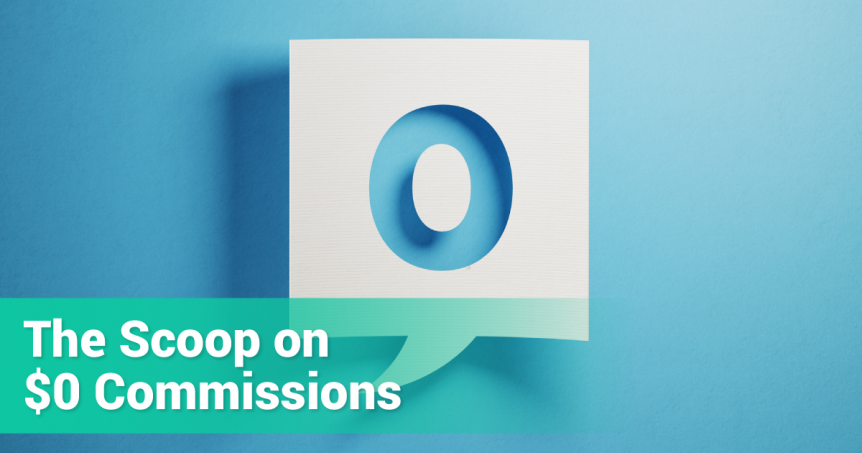Robinhood was founded in 2013 with the goal of providing everyone with access to the financial markets — not just the wealthy. The startup discount broker offers free (zero commission) trades on an easy-to-use mobile app. By mid-2018, the startup reached four million customers, surpassing established competitors like E-Trade Financial.
Of course, Robinhood’s zero commission trades caught on and most discount brokers have since abandoned commissions. Charles Schwab, Fidelity, E*Trade and TDAmeritrade eliminated commissions for online trades of U.S.-listed stocks, exchange-traded funds (ETFs) and stock options in short order, ushering in a new era of free trading for retail investors.
Let’s take a look at the economics of free trades, how brokers really make money and the dark side of zero commissions.
The Economics of $0 Commissions
Most retail investors assume that brokerages make money from commissions. If they’re no longer charging commissions, it’s fair to wonder how they plan to stay in business. This is especially true given that some large discount brokerages have struggled with solvency in the past (e.g. E-Trade), and investors want to ensure their money is in safe hands.
Brokers have been cutting commissions to boost market share for decades. In fact, part of Robinhood’s success was due to its ability to lean on free trades to offset its marketing expenses in building a large user base. The idea of zero commissions has been treated as an inevitability as the industry became increasingly competitive over time.
The reality is that commissions account for a relatively small slice of total revenue for most discount brokers. In 2018, Charles Schwab generated just ~7% of revenue from commissions while TDAmeritrade topped the group at ~28% of revenue. Discount brokerages made the majority of their revenue from other products and services that investors rarely consider.
How Brokers Make Money
Discount brokerages make most of their money the same way as a traditional bank — net interest margin. On average, brokerage customers keep about 10% of their account value in cash. These brokerage accounts pay very little yield on cash, which creates an opportunity for the brokerages to invest a portion of it into higher-yielding assets and keep the difference.
Asset management is another big source of revenue for discount brokers. For instance, Fidelity is well-known for developing its in-house ETF products that involve their own set of expense ratios. The company initially offered commission-free trading only for these products, but made a lot of the money back through annual management fees on the funds.
Securities lending, or lending a customer’s securities to a short-seller, accounts for a small (but not insignificant) portion of revenue for many brokerages. Short sellers borrow and immediately sell securities for cash with an agreement to repurchase them in the future. They make money if the market value of the security falls and they buyback at a lower price.
Finally, discount brokerages receive some payments for their order flow. While the process is somewhat involved, so-called internalizers pay brokerages to route order flow to them and act as a market maker with a lower spread (and better price) than the public markets. They only deal with retail accounts and therefore don’t face as much liquidity risk.
The Dark Side of $0 Commissions
Free trades may seem like a great deal for retail investors. After all, you’re paying less money out of pocket to buy and sell the same stock. You can also afford to invest small sums of money without worrying about the high cost of commission affecting returns (e.g. a $7 flat commission on a $100 trade is an immediate 7% loss on the position).
As with most free things, the reality is a little more nuanced. There’s a reason for the euphemisms “nothing in life is free” and “if it’s too good to be true, then it probably is”. Before ditching your current brokerage and switching to a commission-free alternative, you should carefully consider these factors and make an informed decision.
Research has shown that frequent traders tend to underperform the market by ~6.5%. While some underperformance comes from higher commissions, frequent traders also tend to buy and sell at the wrong times. For example, fearful traders would have likely sold after a crash and bought too late in the recovery, leading to below-market performance.
Brokerages will also have to find other ways to make money after slashing commissions. While commissions were very transparent, these other methods may be a lot more opaque. You could have been much better off paying a modest commission if a discount broker decides to increase asset management fees or reduce their interest rates on cash, resulting in higher costs.
In addition, brokerages may neglect to invest in some areas of their business if they don’t generate revenue from trades. There’s less incentive to spend money on platforms designed to encourage more frequent trading if it doesn’t directly impact revenue. In fact, they may spend more on trying to up-sell advisory services or other revenue centers.
The Bottom Line
Zero commissions have become the new normal for the discount brokerage industry. While it’s tempting to praise the decision as a win for retail investors, the reality is a lot less certain and will require time to play out. It’s important to remain vigilant when evaluating your discount brokerage and base your decisions on more than just commissions.
There’s even evidence that zero commissions may not be the end. In fact, some brokerages actually pay customers to trade since they make money back in other ways!
If you’re looking for a way to generate investment income in retirement and avoid overtrading, try the Snider Investment Method! By writing call options using our simple and effective system, you can generate a consistent income from option premiums without sacrificing the upside potential for stocks for fixed income investments.
Sign up today to take our free e-course and learn more!







